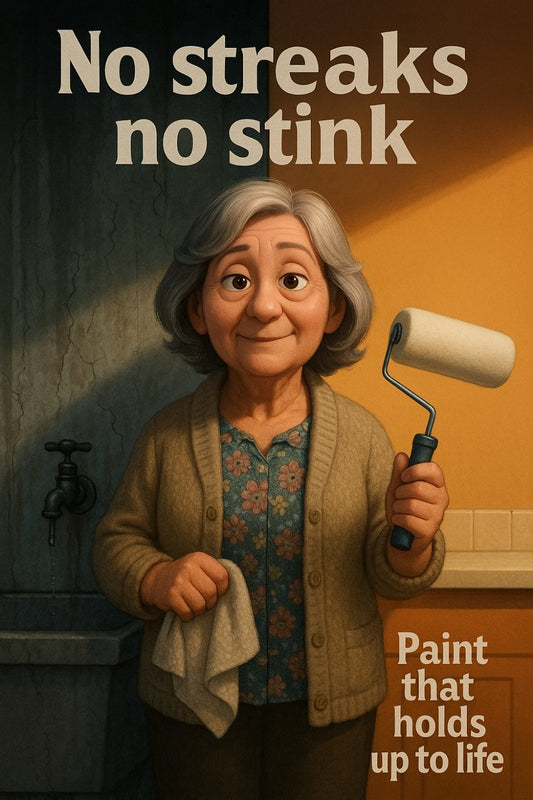
How to stop drips and streaks before they wreck your walls (and your weekend)
Share
When Paint Misbehaves — How to Avoid Drips and Streaks for a Flawless Finish
The nightmare scenario: You've prepped. You've planned. But your fresh coat turns into a patchy mess.
You've got the drop sheets down and the smell of fresh paint in the air. You're halfway through the second wall and... there it is. A dreaded thin streak running from ceiling to skirting. Or worse – a fat, glossy drip hardening in place like a rogue teardrop.
It’s enough to make anyone sigh over their stir stick. But here’s the good news: streaks and drips aren’t just bad luck. They’re the result of a few simple mistakes — and as with any DIY bugbear, they’re completely avoidable with the right approach.
“Paint isn’t just about colour — it’s about control. The roller talks to the wall the same way a brush dances across trim. When either one stumbles, the finish tells the story.” — Candeece Hall, Paint Consultant
Let’s Get Real — Why Do Drips and Streaks Happen?
Sometimes it’s the paint. Sometimes it’s the tools. But more often than not, it’s about rhythm and consistency. Here's what usually goes wrong:
- Overloading the brush or roller: Too much paint all at once causes gravity to do what gravity does.
- Poor quality tools: Cheap brushes shed bristles and cheap rollers don't hold paint evenly.
- Skipping prep: Uneven, dusty, or glossy surfaces prevent good adhesion and lead to uneven drying.
- Wrong technique: Not blending in wet edges or going back over semi-dry patches creates stripes.
Drop the Panic — Do This Instead
Ready for a smoother path? Here’s how to keep your paint right where it should be — on the wall, looking clean and sharp.
1. Start with Proper Surface Prep
You wouldn’t paint a muddy fence. So don’t ignore walls that feel chalky, glossy, or greasy. Sand back old flaking layers, clean away cobwebs, and patch up holes with compound. A surface that’s clean, dull, and dry is a surface that'll behave.
2. Use a Quality Primer
This one’s not just for the perfectionists. Primer creates a consistent base, especially over repaired spots, darker colours, or tricky materials like MDF or bare timber. It helps your topcoat cling without drama.
3. Go Easy on the Paint Load
The trick isn't how much paint you pick up — it’s how you roll with it. Dip your brush or roller about a third of the way in and tap (don’t wipe) the excess. You’re going for coverage, not puddles.
4. Apply in Thin, Even Coats
Two thin coats are worth more than a single sloppy one. Let the first coat dry fully before applying another. Rushing leads to streaks, especially in darker colours where every brush line shows up like a sore thumb.
5. Watch the Weather
Painting on humid or really hot days? You’ll be battling fast drying times — or painfully slow ones. Both mess with your finish. Aim for dry, mild days if you can, and never paint in direct sunlight.
6. Keep the "Wet Edge" Alive
The golden rule of rolling: Don’t let the edge dry mid-job. This means working in a W pattern across small sections and overlapping slightly into still-wet areas. If you pause for tea, pause at a natural break point.
7. Clean Your Tools as You Go
Don't let paint dry on the brush mid-task. If you're not switching colours, wash and spin rollers at the end of the day and wrap brushes in cling film between coats. Gummy bristles = drag marks.
Bonus: Tricks from Painters Who’ve Seen It All
- Use angled brushes for corners: They offer more control and don’t splatter like flat brushes do.
- Switch rollers for walls & ceilings: Use long nap for textured surfaces and short nap for smooth walls.
- Light up your work: Use a lamp or torch side-on to see streaks or missed patches before they dry.
- Sand lightly between coats: A quick 240-grit buff (once dry) removes raised fibres and dust mounds.
But What If You’ve Already Got Drips?
Deep breath — it happens. If the paint is still tacky, gently feather the drip out with a clean brush or roller. If it’s dry, sand it back lightly, dust it off, and repaint the area. No one will ever know.
Why the Paint You Pick Matters
All paints are not born equal. Cheaper ones skimp on coverage and leave behind more brush marks, especially on trims and doors. Look for paint trusted by the tradies — the sort of stuff that covers faster, levels smoother, and doesn’t turn gloopy after five minutes in the tray.
This Is the Part Where You Breathe Easy
You don’t need painter’s tape for nerves. With the right prep, tools, and rhythm, anyone can get a streak-free result. The drips don’t define you — they just remind you to slow down, load the roller right, and keep that edge wet.
And if your next project feels bigger than a single brushstroke, drop in and ask for some advice. Sometimes the smartest move is just chatting to someone who’s done it all before.
Happy painting,
— Candeece

Stay Connected
Follow our Facebook Page: Strathalbyn H Hardware on Facebook



